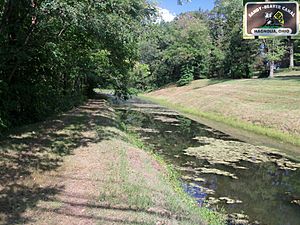Sandy and Beaver Canal facts for kids
The Sandy and Beaver Canal was a waterway that helped transport goods and people in Ohio and Pennsylvania. It stretched about 73 miles (117 km) from Bolivar, Ohio, to Glasgow, Pennsylvania. This canal had many special sections called locks, which are like water elevators that help boats move up and down hills. There were 90 locks in total!
The canal was planned in 1828 and finally finished in 1848. However, it faced many problems, especially in its middle part. The canal stopped working completely in 1852. This happened when the Cold Run Reservoir Dam near Lisbon, Ohio, broke. This dam failure ruined a large part of the canal, making it unusable.
Contents
Planning the Canal's Route
In 1828, a man named Major D.B. Douglas from the United States Military Academy at West Point surveyed a possible path for the canal. His plan was for a canal about 90.5 miles (145.6 km) long. It would have included seven aqueducts (bridges that carry water), 100 locks, and a very long tunnel.
However, Douglas's plan was not chosen. Instead, a group in Philadelphia thought another canal, the Pennsylvania and Ohio Canal, would be a better way to connect Ohio and Pennsylvania's waterways.
Building the Sandy and Beaver Canal
Even without support from Philadelphia, people who wanted the canal decided to go ahead. In 1834, they met in Waynesburg, Ohio. They hired two engineers, Hother Hage and Edward H. Gill, to design the project. They made some changes to the earlier plans.
The canal they built was 73 miles (117 km) long. It had three main parts:
- Western Division: This part connected to the Ohio and Erie Canal. It had a 400-foot (120 m) long aqueduct that was 28 feet (8.5 m) above the Tuscarawas River. This section also included 33 locks, five miles (8 km) of calm water areas called "slackwater," and two reservoirs (large water storage areas). It rose about 220 feet (67 m) in elevation.
- Middle Division: This 14-mile (23 km) section was at the highest point of the canal. It featured two tunnels and two reservoirs. The "big tunnel" was about 900 to 1060 yards (820 to 970 m) long. The "little tunnel" was about 1000 feet (300 m) long. Both tunnels were about 17 feet (5.2 m) high.
- Eastern Division: This part was 27 miles (43 km) long and dropped in elevation towards Glasgow. It had 57 locks, 20 dams, and 17 miles (27 km) of slackwater.
Challenges and Closure
Building the canal was a huge job, but it faced big problems. Construction slowed down because of financial difficulties during a time known as the Panic of 1837. This was a period when the economy struggled, and many businesses faced money problems. The number of workers on the canal dropped from 2,000 to just 200.
Because of these money troubles, not much work was done for seven years. The tunnels, which were a major part of the project, were finally finished in 1848.
However, the canal's life was short. In 1852, the Cold Run Reservoir Dam broke, causing a lot of damage. Also, the Cleveland and Pittsburgh Railroad was built that same year. Railroads were faster and more efficient, and they started taking away business from canals.
A small part of the canal, about six miles (9.7 km) on the west end, was used to feed water into the Ohio and Erie Canal until 1884. That's when a flood destroyed the aqueduct, ending its use completely.
What Remains Today
Today, an original dam near Waynesburg still holds back water on the Sandy Creek. This water feeds a section of the old canal downstream towards Magnolia, Ohio.
Most of this privately funded canal was in Ohio. Only about 0.75 miles (1.21 km) of it was in Pennsylvania.


